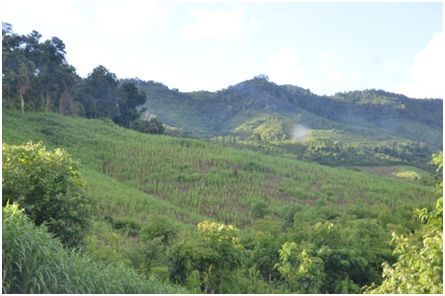Since 1999, Social Policy Ecology Research Institute - SPERI (merged from three Vietnamese NGOs: Towards Ethnic Women -TEW, Center for Human Ecology Studies of the Highlands - CHESH, and the Center for Indigenous Knowledge Research and Development - CIRD) and Center for Human Ecology Studies of the Highlands in Laos, so-called CHESH Lao have cooperated with different Laos’ stakeholders to conduct on-going research and facilitate the model of Hmong’s customary law-based community forest governance in Long Lan village, Luang Prabang district, Luang Prabang province, Laos.
Given the success of Long Lan model, Luang Prabang provincial and district authorities have requested SPERI and CHESH Lao to further research the current situation of land, forest and water management in the Kuang Si Waterfalls region in order to suggest appropriate solutions for effective co-governance of natural resources in 9 villages of Luang Prabang, Xieng Ngan and Muong Nan districts. Yang village of Luang Prabang district has been selected to be the main case study.
On August 19 – 20, 2014 the conference
“Community Cultural Identity and Livelihood Identity towards sustainable development of Kuang Si Waterfalls” was co-organized in Yang village by CHESH Lao and the Yang’s leaders. 120 participants representing for Luang Prabang, Xieng Ngan and Muong Nan district leaderships and local peoples i.e. traditional village leaders, elders and villagers from 9 villages in the Kuang Si Waterfalls region have attended the conference. Especially, Long Lan’s traditional learders and representatives from the Luang Prabang Self-Help Association also attended the conference.
In the opening speach, Mr. Phonthip, Head of CHESH Lao Office spoke of the conference objectives and 9 criteria set up by Laos government for development and happiness.
Long Lan village leader, Mr. Chy Ly shared lessons learnt from Long Lan pilot on community-based forest and forestland allocation facilitated by CHESH Lao. As his opinion, one of the decisive factors for the success is everything should be consulted and decided by the villagers prior to implementation.
Long Lan’s traditional elders, Mr. Xay Khu Zang and Mr. Chu Sy affirmed that besides the villager’s participation, the local authorities play an important role in forest and land allocation. They also added that resolving land boundary conflicts with the surrounding villages always is a critical challenge that requires the traditional village leaders, elders and prestigious people to together consult for the best and solutions to the conflicts.
During the conference, the participants raised questions regarding how to resolve forest land conflicts, how to get the local people and authorities involved in dicussion and sharing current practical forest land managment situation, then finding out suitable solutions.
After half day of discussion and sharing, the representatives presented their drawings of their own villages as well as traditional plans on natural resources use and management. Through these presentations, the participants gained more understanding of the current situation of natural resources management in each village - the issues and difficulties, as well as local expections and desires towards forest management and development, promotion of traditional culture and customary laws of indigenous ethic minorites living arround the Kuang Si Waterfalls region.
At the end of the two-day conference, Mr. Bun On, Head of Luang Prabang Agriculture and Forestry Office (DAFO) highly apprecitated the conference results including local peoples’ critical opinions. He also expected that representatives of 9 villages would further propose their solutions for effective management, and development of the Kuang Si Waterfalls region. These local solutions would be a basis for local authorities to further build up appropriate policies and plans on forest and land allocation in order to promote livelihood and cultural identities of local indigenous ethnic minority communities.
Conference photos

Figure 1: Forest and landscape and livelihood in Yang village
|
-1.jpg)
Figure 2: Mr. Phon Thip, Head of CHESH Lao Office speaking of the conference objectives and 9 criteria set up by Laos government for development and happinness
|
 copy.jpg)
Figure 3: Mr. Chi Ly, Long Lan’s head sharing lessons learnt from community-based forest and forestland allocation in Long Lan
|
 copy.jpg)
Figure 4: Long Lan Elder, Mr. Xay Khu Zang sharing solutions on resolving forestland boundary conflicts
|
|
|
|
 copy.jpg)
Figure 5: Mr. Si Tha, Yang’s Head presenting community customary law
|
-1 copy.jpg)
Figure 6: Mr. Si Tha, Yang’s Head taking note of opinions contributed by the Yang villagers
|
|
|
|
 copy.jpg)
Figure 7: Mr. Xay Phon, Tha Pen’ Head speaking of the Rain praying ritual in the upper watershed of Kuang Si Waterfalls
|
 copy.jpg)
Figure 8: Mr. Bun Khen, Huoi Han’s Deputy Head speaking of the Pa Ho forest – Hin Tang mountain ritual |
|
|
|
 copy.jpg)
Figure 9: Long Lan Elder, Mr. Cho Sy commenting on Mr. Som Phon’s presentation from Huoi Sieu
|
 copy.jpg)
Figure 10: Mr. Bun On, Head of Luang Prabang Agriculture Office reviewing the conference
|
|
|
|
 copy.jpg)
Figure 11: Mr. Bun On and villages representatives hand in hand to express their determination
|
 copy.jpg)
Figure 12: Group photo of villages representatives
|